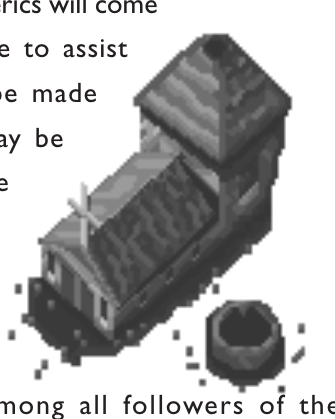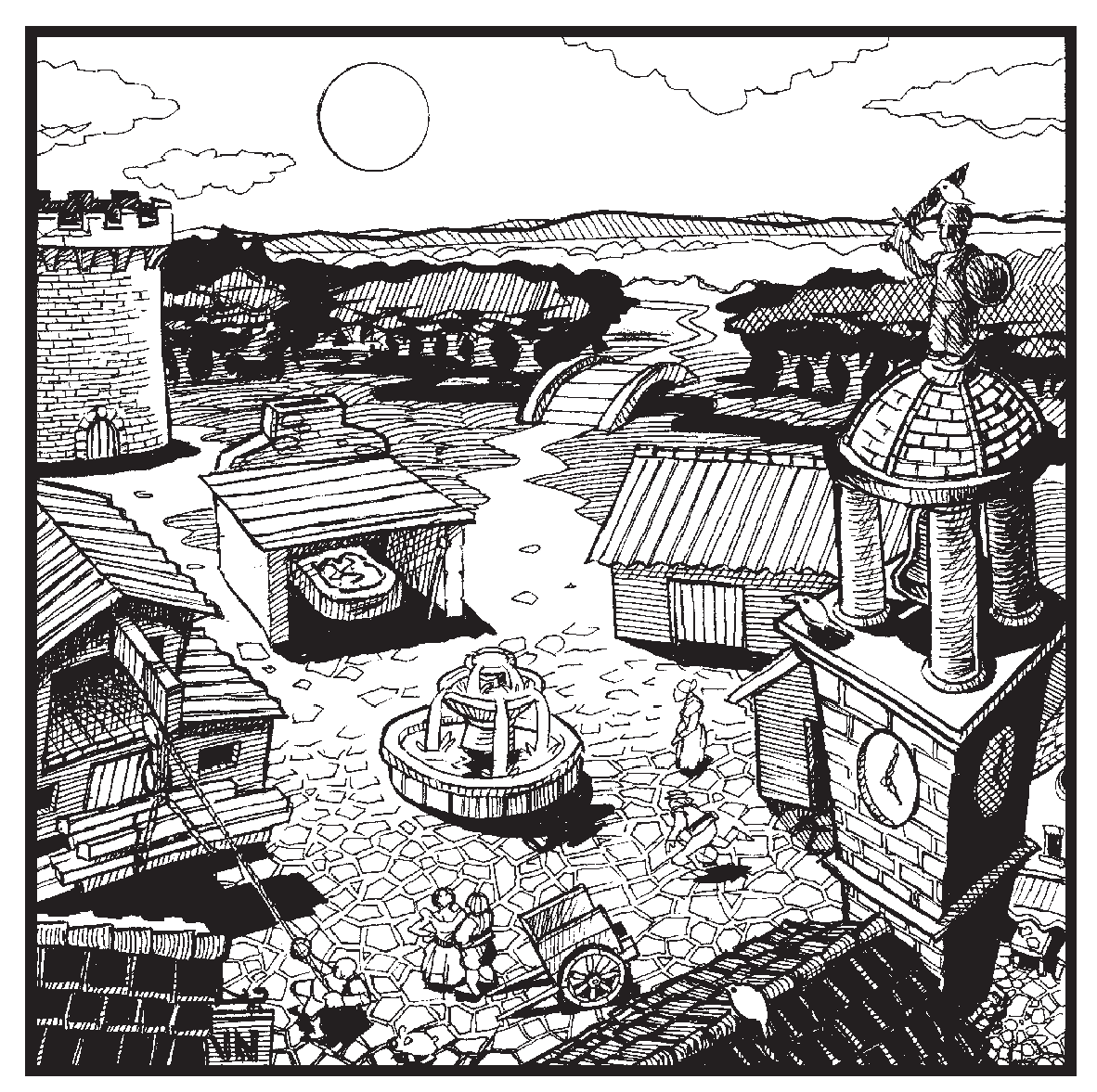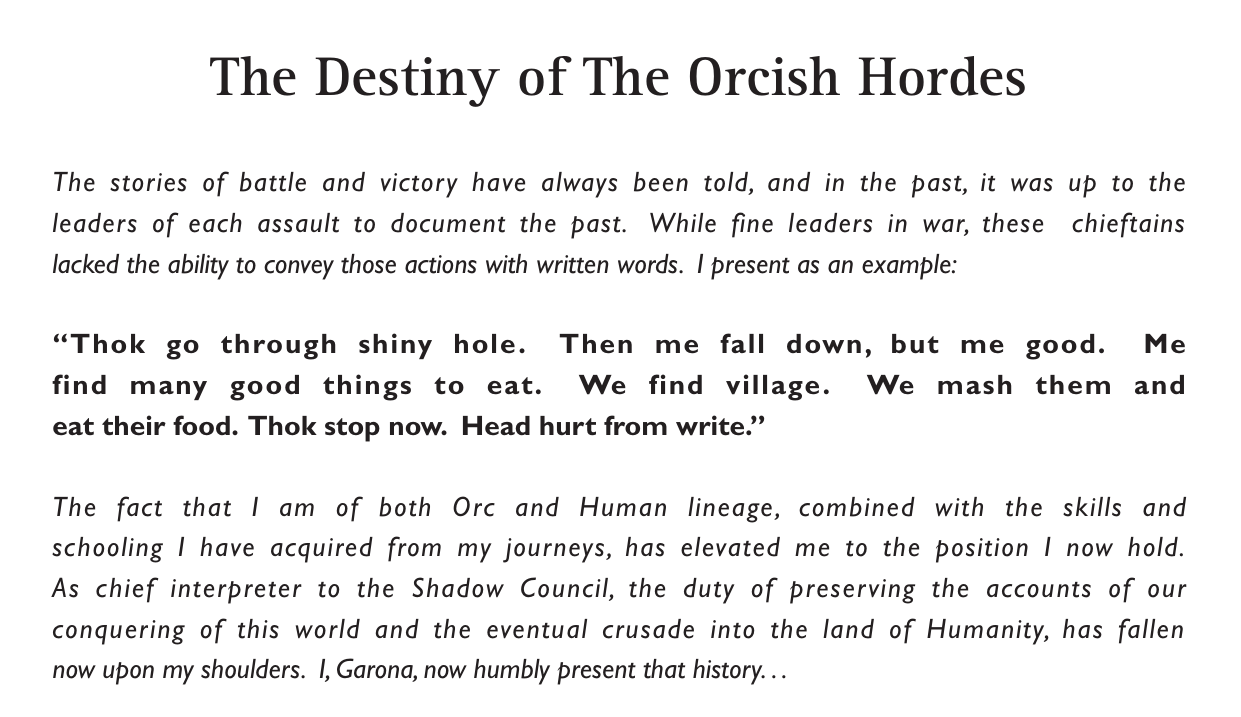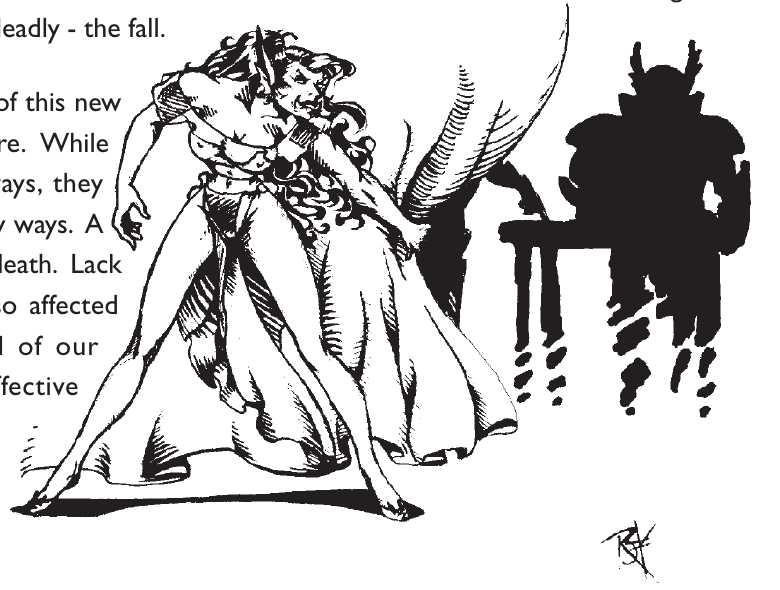Warcraft Retrospective 2: Warcraft 1, the Manual
One day, I did an interesting mental exercise. I rewatched the first Star Wars movie, Episode IV: A New Hope — or rather just Star Wars as it was known at release — pretending I was seeing it for the first time, and knew nothing whatsoever about the Star Wars setting as we’ve come to think of it.
It was a space fantasy story about a young wide-eyed lad named Luke Skywalker who just received his father’s lightsaber from a kind old hermit and learned his first lesson about the mysterious Jedi Knights, forgotten by most of the galaxy and dismissed as a “hokey religion” by those who know of them, and the equally mysterious “Force” they believed in. From there, it would clearly be a long, wild adventure for him and his newfound friends — plucky, outnumbered rebels fighting an uphill battle against the oppressive Galactic Empire, of which so far we only saw an overconfident local governor and a fallen Jedi answering to him.
A New Hope lacks many of the later lore developments that we have come to think of as “the Star Wars setting”. It’s good at creating an illusion of a larger universe, with casual mentions of the just-disbanded Imperial Senate, the Old Republic, the Clone Wars in which Luke’s yet-unnamed father was a prodigy pilot, and so on. But it doesn’t have acrobatic lightsaber battles, or the city-planet of Coruscant, or the Force as a set of MMO buttons to press, or the Mandalorians1, or the Jedi Order as the official peacekeeper corps of a corrupt bureaucratic government past its prime, or “Darth” as a Sith title rather than a personal name, or the Sith, period. All these things were added later, fleshing out the setting, but turning it into something that is completely unrecognizable with only the first movie in mind. On its own, A New Hope takes place in a very broad-strokes setting, in a vacuum; a Space Adventure Story, set in Space.
TV Tropes calls this Early-Installment Weirdness, and Warcraft has it in spades.

Warcraft: Orcs & Humans, or, as I’ll call it in this series, Warcraft 1, is even more unrecognizable in the light of modern lore. Let’s forget everything we know about the Warcraft setting as it exists today, turn back the clock to 1994, and unbox this freshly released game.
Wherefore “Warcraft”?

Warcraft 1 was largely a gamble. Then-upstart game company Blizzard saw a niche — a lack of real-time strategy game releases in 1993 and 1994 since the release of highly successful Dune II — and rushed to fill it. The initial idea, as envisioned by Blizzard co-founder Allen Adham, was to make a series of games about warfare in different settings, some fictional and some historical, such as Warcraft: Vietnam. The name “Warcraft” was suggested by Samwise Didier, the artist who would go on to later create what we now know as Warcraft’s distinctive aesthetic, and by his own admission wasn’t intended to mean anything.2 So not only wasn’t there a single “Warcraft setting” at the time the game was developed, there was no intention to have one.
Of course, these plans never materialized. Players came to love this fantasy world and wanted more games set there. Blizzard later started a separate series of real-time stategy games in a space setting, named Starcraft as an homage to Warcraft. The Warcraft series itself stayed in the fantasy world seeded by the first game, though greatly expanded, retconned in just about every aspect, and very tonally different.
So let’s take a closer look at this newly-released “Warcraft” fantasy game. There must be a reason why the titular orcs and humans are fighting each other, right? To find out the backstory, we will have to turn to…
The Manuals (two of them!)
That’s right, most of the Warcraft 1 lore is not actually told in the game itself. This is 1994, when games are developed for MS-DOS and distributed on floppy disks. (CDs are for the rich.) Every kilobyte counts; it’s easier to print the story and accompanying artwork on paper.
Warcraft 1 actually has two manuals: one for humans and one for orcs.3 Each manual covers the lore from the in-universe perspective of that race. It’s a clever idea; each side has biases and is viewing the other side through their lens. Both stories are told by in-universe narrators: Sir Lothar4 for the humans and Garona of the Shadow Council for the orcs. This tradition of first-person, unreliable narration would later persist into the decanonized Warcraft RPG books.
The manual is readily available online in PDF form, and Warcraft Wiki has a copy of it as a web page. Let’s take a closer look.
The Humans

For a strategy game in an original setting where most of the levels are generic “destroy the enemy base” missions, Warcraft 1 has a surprising amount of backstory in the manual.
The human lore section is written, in-universe, by Sir Lothar, Armsman to the Brotherhood of the Horse. It is titled Chronicles of the War in Azeroth, describing, year by year, the recent history of the Kingdom of Azeroth.5 Yes, you read it right: “Azeroth” here is clearly the name of the human kingdom, not the entire world, which is not named.
Warcraft Wiki calls the chronology used in this document “the King’s Calendar”, but it appears to be their invention, since I can’t find it used as an official term in any Blizzard sources. Roleplayers have since adopted it as a kind of consensus headcanon term.
Here’s a condensed version.
- Year 5596: During the reign of King Wrynn III7, marked by peace and prosperity, Medivh is born to the court conjurer and a mysterious traveler. Both of them are unnamed in this manual.
- Year 564: Prince Llane is born. King Wrynn gives every citizen a gold sovereign to mark the occasion.
- Year 571: Medivh comes of age, and is expected to become Apprentice Conjurer to the Court. However, dark dreams begin to trouble him, and a strange fire ignites in his eyes, and he bursts with strange, unholy magics painful to him. His father, the Conjurer, fights him, aided by a hundred clerics from Northshire Abbey. Together, they manage to contain Medivh, who falls into a coma. His father drops dead, drained of life.
- Year 577: Prince Llane comes of age. Medivh awakens from his sleep, freezing the royal guards in place with a mere wave of his hand, and explains that the clerics watching over him all these years helped him learn to control his powers. He gives King Wrynn a gift: an enchanted hourglass that never empties despite the sand constantly falling. He explains that as long as the glass doesn’t empty, the reign of King Wrynn won’t fail.
- Year 583: The lands gradually fall to a strange sickness that puzzles clerics and conjurers alike. As the hourglass empties, Stormwind Keep is suddenly assaulted by unknown creatures — described as “gross deformities, a cruel reflection of humanity”. King Wrynn sends knights to Northshire Abbey, but they’re unsuccessful in driving the “foul beasts” to extinction.
- Year 584: Llane becomes King of Azeroth. The invading creatures are identified as orcs, universally described as “cruel, sadistic and vile”, and their base is found in newly-formed swamps to the east.8
- Year 593: The “Orcish hordes”9 have been driven back into the swamps. A mysterious traveler visits King Llane, identifying herself as Medivh’s mother. She explains that she coupled with the King’s Conjurer to have a child to whom she could pass her knowledge and power, but other, unforeseen forces intervened, making him “a beacon of mystic power” and driving him insane. Mother and son battled, leaving both weakened, and at the end, Medivh magically banished her from his domain. The traveler warns Llane that at some point Medivh will have to be dealt with before his power becomes too strong.
The chronicle ends with the mention of Blackhand, a newly risen War Chief10 gathering the feuding orcs under one banner. Lothar is seeking recruits for the inevitable war.

Next come the unit descriptions: the peasant, footman, archer11, knight, and catapult. The black-and-white art is pretty generic faux-medieval European fantasy; nothing about it screams “Warcraft”. Then come the caster units: the cleric and the conjurer. The latter is a pretty standard elemental mage, the spells being Elemental Blast, Summon Elemental, Rain of Fire, and… Summon Scorpions? Huh. One of these things is not like the others. Cleric spells, meanwhile, have some actually interesting lore!
- The cleric’s Healing spell is said to work by channeling the spirit of humanity. The pain and injury of the patient is divined among all humankind, making it easier to bear — described as “carrying the cross of another”.
- The cleric also has Holy Lance, a damaging spell: “As the archangels took up swords of light to defend the heavens, so must we take up holy arms to defend our lands.” Yes, the imagery here is pseudo-Christian through and through.
- Invisibility is also a cleric spell here, and is described to be used to ease confessions.
- The last cleric spell is Far Seeing, described as allowing the caster to see “in an all encompassing fashion, as God does”.
So, to summarize, the religion of the Kingdom of Azeroth follows a single God, believed to be all-seeing. There’s also a belief in the heavens, defended by archangels with blazing swords. And its symbol is… wait for it…
The cross.
We can only hope it will be explained in future installments what its significance is in this particular universe.

The buildings are unsurprising. There’s a bit of interesting lore for the buildings used to recruit the caster units — the Church and the Tower.
- A church must be built entirely of a rare wood known as Holyoak.
- Orcs are described as “hellspawned”.
- Conjurers are a reclusive lot, often place themselves above the law, and teach their art in secrecy. Their towers must be built to exact specifications, which include a mystic lightning rod so the building doesn’t explode from channeled magic.

Finally, we get to the neutral units. Notably, humans know about ogres and daemons, but don’t know how they came into their world — that’s only revealed in the orc manual. Skeletons seek victims to drag into Hell with them. And then there are the water and fire elementals, which look… very, very different from later installments.
And that concludes the human section of the manual. To summarize, the humans don’t know where the orcs come from, but view them as twisted, cruel mockeries of humanity. There’s also this weird aside about Medivh, his unexplained powers, the unidentified dark force behind them, and his growing threat to the world. It’s also not explained where he got his hourglass from, or if he has any connection to the orcs and their invasion of the human world.
It’s interesting. It presents a society that’s basically standard medieval fantasy with magic, but it hints at a larger world, at things beyond current human understanding. Something, or someone, is manipulating Medivh behind the scenes, and his story is surprisingly elaborate for someone who features — as we’ll soon see — in one campaign mission and is not heard of again. So despite the simple premise of orcs invading human lands, the writers have already seeded mysteries to build on as possible sequel hooks.
The Orcs
Let’s look at the other side of the conflict.
The in-universe author of the orc manual is credited as Garona of the Shadow Council, a half-orc half-human.12
This is curious because the manual doesn’t ever mention what the Shadow Council is, or who else is on it. In fact, compared to the human manual, the orc manual is downright scarce on individual characters: the only ones mentioned are Garona herself and War Chief Blackhand. We only get passing mentions of groups or organizations, like the Warlocks and the Necromancers. The worldbuilding is vaguer overall.
So what do we learn? Well, Garona’s document begins with this foreword:

Yikes.
These orcs talk like stereotypical “barbarian monsters” from old-school D&D. We don’t know if Garona’s ability to write in fluent grammar is a result of her half-human heritage or these skills and schoolings she acquired from her journeys. (I’m sure her backstory will be an excellent future story hook, and not at all contradictory.) Fortunately, this passage is of no consequence to the actual game, where orcs only communicate verbally and in complete sentences.
Here’s the backstory, as told by Garona, condensed. Unlike the human chronicle, no dates are given.

- The orcs were conquerors on their unnamed home world. Over centuries, their armies subjugated and enslaved their enemies, aided by their Warlocks and Necromancers, and wherever they went, the land itself withered and died. (This is notable because it establishes that the orcs had multiple enemies on their home world. The ogres were one of these enemies, as described in their entry, but no others are introduced yet.)
- After conquering everyone else, the orcish clans, still driven by their desire to expand, turned against each other.
- The Necromancers were pleased by the ensuing bloodshed, but the Warlocks were not. Fearing that the unending feuds would leave no orcs alive, they sought a new common foe for the clans to fight together. Eventually, they noticed a small dimensional rift and expanded it, allowing a single scout to pass through.
- The scout brought tales of a strange new world that sounded unbelievable. The Warlocks worked on expanding the rift — described as “a blue circle of energy, roughly two and one half Orcs in width”13. Other orcs followed and soon sacked a village inhabited by weaker creatures — “small, pink14, and spare of muscle”. The orcs slaugthered these inhabitants (“the males offered some small resistance, but the females and children were like taking grok to the slaughter”15) and ate their livestock, and what they couldn’t eat, they burned.
- The orcs learned that these people, like themselves, could be killed by injury or starvation; and by torturing their prisoners, they learned that they were called humans, and their land was named Azeroth.
- More orcs arrived through the portal, and as they did, the land around it became as dessicated as their home world. They almost conquered the human capital, but were driven back by formidable mounted warriors — knights.
- Fifteen years passed since then. An orc of unparalleled cunning and guile arose, called Blackhand. He was declared War Chief, studied human strategy to better learned how to counteract them, and united the “Armies, Warlocks and Necromancers” (the latter two called, curiously, “houses of the arcane arts”)16 under his command, preparing for a decisive strike to destroy humanity. “The Age of Chaos is now at hand”.
Like with the human manual, the various buildings and units are described next. Peon, grunt, spearman (who throws spears), raider, and catapult, all identical in stats to the corresponding human units; no big surprises here.
Notably, the orc caster units are the necrolyte, described as having “power over all things dark and evil”, and the warlock, commanding “the energies of the underworld” and “the very essence of evil”. That’s some card-carrying villainy out there. The neutral creatures are described as well, and we learn the origin of the ogres (they came from the orcs’ world through the portal, and hate both races) and the daemons (they’re hellspawn “forged in the fires of Hades”, summoned by warlocks).
Interesting lore tidbits:
- Warlocks are followers of the underworld, which seems to be synonymous with Hades.
- The necrolyte Raise Dead spell works by binding the bodies of the dead to Hell, creating soulless armies.
- “When an Orc dies, his soul descends into Hades for judgment, and his essence is divided into good and evil.” Implying that orcs are not wholly evil!
So to summarize: the human kingdom in this world has generic medieval European aesthetics and a Christian-coded human religion, worshiping God, complete with crosses. There’s also a Hell, clearly inspired by pop culture depictions also based on Christianity. It seems that “Hell”, “Hades” and “the underworld” are different names for the same place.
This is not modern Warcraft. Not yet. This is Diablo17 with orcs.
The Moral of the Story
The Warcraft 1 manual paints a very different world than we know from even Warcraft 3 and vanilla World of Warcraft, let alone Dragonflight. Azeroth is the name of a single human kingdom rather than the whole world; while humans and orcs come from different worlds, these worlds are yet unnamed; human culture is more like medieval Christian Europe, even worshiping God, than the Light-worshiping society seen in later installments; elves, dwarves, and all other playable races are never mentioned; the orcs are self-described evil and ruin the land by their very existence; and the overall aesthetic of the world described in the manual is closer to Diablo than the Warcraft we know.
The TV Tropes article on Early-Installment Weirdness acknowledges that the first installment of a franchise is like a prototype, a rough draft for a book. I don’t think it’s correct to call it “weirdness”, though; continuity drift is a matter of perspective. The world of Warcraft 1 isn’t “weird”. It’s internally consistent and has a clear tone to it, it’s just very different from what we’re used to now. It’s the current Warcraft setting that would feel very weird for people who only knew about the first game before being exposed to it.
We’re also presented with a few mysteries here. On the human side, there’s the strange dark power puppeteering Medivh. On the orc side, there’s Garona’s backstory, as well as the Shadow Council. Who are they? What is their role? What were the travels Garona speaks of and how did she join the Shadow Council? How can she even exist when the orcs only discovered the human world fifteen years ago? Different continuities have given different answers to some of these questions, and some answers necessitated really messy retcons.
I’ll postpone my overall thoughts on Warcraft 1 and its role for the franchise until we look at the game itself. Next up: the orc campaign!
Screenshot from Star Wars Episode IV by Lucasfilm Ltd., taken from starwars.com.
-
Who, for a culture extrapolated from one guy who never took off his helmet before being unceremoniously killed, turned out to be surprisingly interesting. ↩
-
Remember this. It will be important later. ↩
-
These are the two sides of the conflict the game is about; none of the other eventually playable races have been invented yet, and even the human and orc aesthetics are very different from later games. ↩
-
Just Lothar for now. His first name, Anduin, after the river from The Lord of the Rings, won’t be revealed until Warcraft 2, consistent with the setting evolving from “generic quasi-medieval Europe” into more Tolkien-inspired fantasy. ↩
-
Known as the Kingdom of Stormwind in modern lore. ↩
-
In the modern chronology, Medivh was born in year 45 before the Dark Portal, but I don’t know if it’s right to say that the difference between the calendars is 604 years (559 + 45), since practically everything about the Warcraft 1 manual has since been retconned. To my knowledge, no later source establishes what event served to establish the initial year of the Warcraft 1 calendar. Also, in this calendar, orcs appear at Stormwind Keep in year 583, so clearly the Dark Portal was already operational by then. The chronologies don’t match, period. ↩
-
“Wrynn” is clearly intended to be a given name here, not a family name. The name of Llane’s father, known in modern lore as Barathen Wrynn, has a complicated history. We’ll talk about it when we get to the installments that retconned it — twice. ↩
-
The implication here is that the swamps formed after the orcs arrived, consistent with the orc manual claiming that their mere presence defiles the land around them. ↩
-
There’s no mention of a singular capital-H Horde. ↩
-
Yes, “War Chief”, not “Warchief”. It will be a while before nounnoun and nounverber names become a Warcraft staple. ↩
-
Human. Elves of any kind aren’t part of Warcraft lore yet. ↩
-
She’s unambiguously identified as half-human in the manual. Of course, it makes little sense even here because orcs have only been to the human world for fifteen years when the story begins, not enough time for an adult half-human half-orc to exist. ↩
-
It’s not named. Also it’s described very differently from the Dark Portal first seen in Warcraft 2. ↩
-
This is 1994. Humans are white unless noted otherwise. Humans from European-coded societies are definitely white. ↩
-
Humans are presumed to have traditional gender roles, a far cry from the egalitarian Azeroth of today. And what’s “grok”? It’s clearly a kind of animal that orcs eat, but they haven’t been mentioned in any later source and no pictures of them exist. ↩
-
The type of magic wielded by warlocks is, of course, unnamed. “Arcane” seems to be a catch-all term for magic in general, not a specific type of magic as it became later. ↩
-
Which also hasn’t been invented yet. Diablo 1 won’t come out until 1997. ↩
Leave a Comment